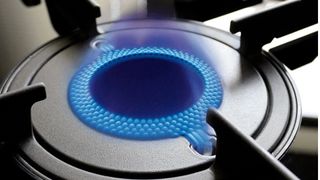I just switched to a gas-on-glass cooktop — here's what happened
The best of both worlds?

When I renovated my kitchen this year, I just couldn't bring myself to part with a gas cooktop. I've been cooking on gas for my whole life, and while we've waxed lyrical about the perks of induction cooktops and electric ranges here at Tom's Guide, I wasn't quite ready to make the switch. On my search for a new product though, I came across a product that seemingly combines the best of both worlds: a gas-on-glass cooktop.
The power of gas cooking combined with the sleek looks of a glass cooktop? I was instantly sold. I opted for the Hotpoint Gas on Glass FTGHG, which is a product you'll only be able to get your hands on if, like me, you're based in the U.K. These products are available in the U.S. from the likes of KitchenAid and GE, and if you're wondering if they're right for you, let me tell you my pros and cons after using one in my own home for 6 months.
What are the pros of a gas-on-glass cooktop?
1. Looks

First off, gas-on-glass cooktops look great. As I was updating a 40-year old kitchen, I wanted to bring a more modern look to not only the cabinetry and countertops, but also my appliances. I opted for a black oven, fridge and dishwasher, and I was so happy when I found a gas cooktop that didn't come with a metal base. Instead, my cooktop features sleek black glass that nestles seamlessly into my cooktop.
2. Full control

My student house had a cheap electric cooktop, and it was the bane of my existence. I'm certain that there are plenty of responsive, high-powered electric options out there, but my student landlord had no interest in giving us the best of the best, so I was stuck with a sluggish stove that took minutes to heat up, and if I overshot on the temperature, it was all too easy to burn my food while I waited for the cooktop to correct itself.
With gas, I feel in complete control. The temperature can be adjusted instantly, and you can see it happening thanks to the flames that heat the pan directly.
Exclusive to my Hotpoint stove is the Direct Flame Technology which disperses the gas flame across 420 small holes in the cast iron grate. These look incredibly modern, but they also prevent energy loss.
3. I'm not worried about mishaps

I saved for years to get a new kitchen, and even 6 months in, I'm still very precious about cleaning my surfaces and wiping down the tiles. I'd absolutely hate for any damage to come to my shiny new fittings, which is a common concern for those who opt for a glass cooktop. All it takes is for a roughed-up pan to scrape across the surface, and your cooktop is scratched beyond repair. And if you drop anything while you're cooking, you could well risk breaking the glass itself.
Sign up to get the BEST of Tom's Guide direct to your inbox.
Get instant access to breaking news, the hottest reviews, great deals and helpful tips.
The gas-on-glass cooktop feels like the best of both worlds in offering the aesthetic value of a glass cooktop, with metal grates that elevate pans to prevent scratching or cracking. I can also rest my favorite cookware on the stove without triggering any automatic sensors, which is something I've found annoying with induction cooktops when I've used them in the past.
What are the cons of a gas-on-glass cooktop?
1. Cleaning is trickier

I've yet to master how to clean a glass cooktop. I frequently cook at high heats, so I'll regularly get splatters of sauce and oil on my cooktop surface that can take some buffing to remove from my glass cooktop.
On the plus side, these splashes don't get baked onto the glass surface as they might with an electric cooktop. but they do mark up my cast iron grates, which require some scrubbing.
2. Reassembly is fiddly

This cooktop may offer the best of both worlds, but it also brings with it some of the negatives of gas ranges. I clean this cooktop most days, and to get the best clean I need to remove the cooking grates.
The grates slot into the glass surface in quite a specific way, so it can be fiddly to get them in the right spot. With time though, I've picked up a knack for it.
Should you buy a gas-on-glass cooktop?
After 6 months of use, I think the pros of cooking with a gas-on-glass cooktop vastly outweigh the cons. If you don't love the look of traditional gas stoves but still want total control over your cooking, I think this is the perfect option for you. Just be prepared to spend a bit more time cleaning around the grooves and dials, and remember to wipe down the glass after every use.
More from Tom's Guide

Millie is the Senior Home Editor at Tom's Guide. She's been reviewing home tech for over five years, testing everything from coffee makers to the latest vacuum cleaners. Starting out in 2019 as a Staff Writer at TopTenReviews, Millie then moved on to Future's Homes portfolio, where she eventually oversaw all product testing as Head of Reviews.
With particular expertise in cookware and kitchen appliances, you'll struggle to find an air fryer Millie's not tested. She's traveled the world reporting on the latest home innovations and product launches, learning how to use pizza ovens from Pizzaiolos in Naples, and touring the De'Longhi factory in Venice.
When she's not reporting on home and appliance trends, Millie loves watching live music. She's currently learning the guitar - naturally, she plays a Fender.